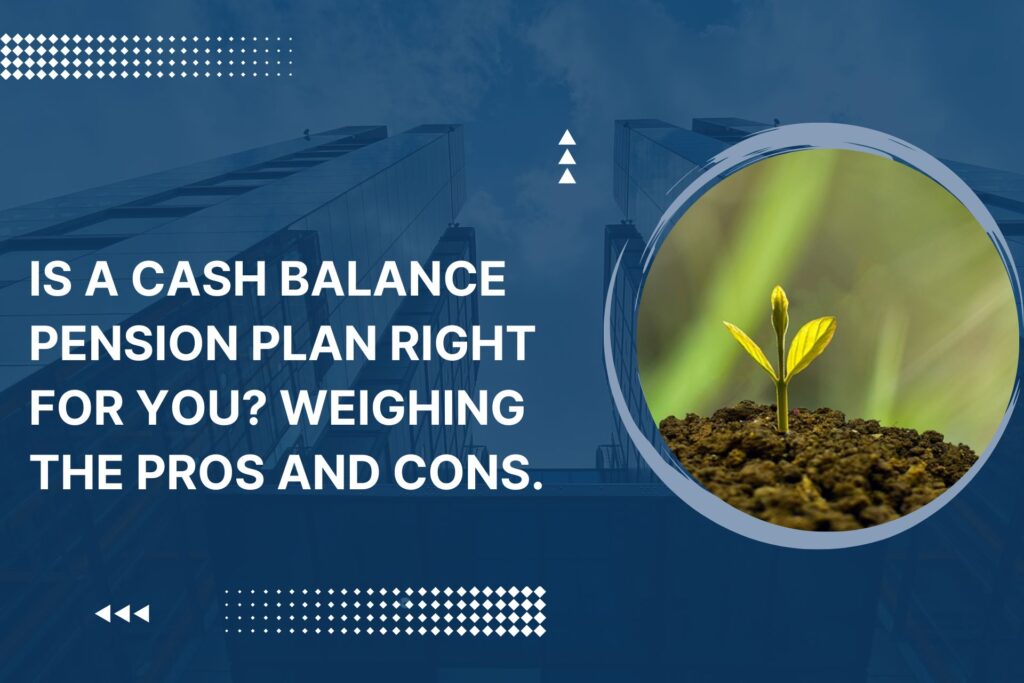Making decisions about your retirement can be daunting, especially when it comes to complex financial options like pension plans. That’s why we’re here to help you navigate the pros and cons of a cash balance pension plan. In this article, we’ll break down the basics of this retirement savings vehicle and explore its advantages and disadvantages. With a cash balance pension plan, you can potentially enjoy the security and stability of a traditional pension while also benefiting from the flexibility and portability of a 401(k). However, it’s important to understand the potential drawbacks, such as limited investment options and the potential for lower returns.
By weighing the pros and cons, you can make an informed decision about whether a cash balance pension plan aligns with your retirement goals. So let’s dive in and explore if a cash balance pension plan is the right choice for you.
What is a cash balance pension plan?
A cash balance pension plan is a type of retirement savings vehicle that combines features of both traditional pension plans and 401(k) plan. It offers the security and stability of a traditional pension while also providing the flexibility and portability of a 401(k). In a cash balance pension plan, your employer contributes a percentage of your salary to your individual account each year, and these contributions grow at a fixed rate of interest.
Unlike a traditional pension plan, where your benefit is based on a formula that considers your years of service and average salary, a cash balance pension plan provides a hypothetical account balance that grows with each contribution and the corresponding interest. When you retire, you can take your cash balance as a lump sum or convert it into an annuity to receive monthly payments.
How does a cash balance pension plan work?
In a cash balance pension plan, your employer makes contributions to your individual account each year. The amount contributed is typically a percentage of your salary, often between 5% and 8%. These contributions are then credited with a fixed rate of interest, typically based on Treasury bond rates or other fixed-income investments.
As your account balance grows with each annual contribution and interest credit, it accumulates until you reach retirement age. At retirement, you have the option to take your cash balance as a lump sum or convert it into an annuity. If you choose the annuity option, you will receive regular monthly payments for the rest of your life.
Pros of a cash balance pension plan
One of the main advantages of a cash balance pension plan is the predictability and security it offers. Unlike a 401(k) plan, where the value of your account can fluctuate based on market performance, a cash balance pension plan guarantees a fixed rate of return on your contributions. This can provide peace of mind, especially for those who are risk-averse and prefer a more stable retirement savings option.
Another benefit of a cash balance pension plan is the portability it offers. If you change jobs, you can take your cash balance with you and roll it over into another qualified retirement account, such as an individual retirement account (IRA) or another employer’s retirement plan. This allows you to maintain the tax advantages of your retirement savings and continue growing your funds without interruption.
Additionally, cash balance pension plans can be advantageous for high-income earners. Since the contributions are based on a percentage of your salary, those who earn more can benefit from higher contribution amounts, potentially allowing them to save more for retirement compared to a traditional pension plan.
Cons of a cash balance pension plan
While there are several advantages to a cash balance pension plan, it’s important to consider the potential drawbacks as well. One limitation of cash balance pension plans is the limited investment options. Unlike a 401(k) plan, where you have a wide range of investment choices, cash balance pension plans often offer a more limited selection. This can restrict your ability to diversify your investments and potentially affect your overall returns.
Another potential downside of cash balance pension plans is the potential for lower returns compared to other retirement savings options. Since the interest credited to your account is typically based on fixed-income investments, your cash balance may not grow as much as it would in a 401(k) plan invested in higher-yielding assets like stocks. This could impact the overall growth of your retirement savings over time.
Lastly, cash balance pension plans may not be suitable for employees who do not plan to stay with their current employer for a significant amount of time. Since the contributions and interest credits in a cash balance pension plan accumulate over time, those who leave their job before reaching retirement age may not fully benefit from the plan’s advantages. In such cases, it may be more beneficial to explore other retirement savings options that offer more immediate benefits and flexibility.
Understanding the risks and limitations of a cash balance pension plan
When considering a cash balance pension plan, it’s crucial to understand the risks and limitations involved. As mentioned earlier, the fixed rate of return in a cash balance pension plan may result in lower overall returns compared to other investment options. This means that if you are comfortable with taking on more risk in exchange for potentially higher returns, a different retirement savings vehicle, such as a 401(k) plan, may be more suitable for you.
Additionally, the predictability and security of a cash balance pension plan can sometimes be a double-edged sword. While it offers stability, it also means that you may not benefit from market upswings as much as you would with a more market-dependent retirement savings option. If you have a higher risk tolerance and want the opportunity for greater returns, a cash balance pension plan may not align with your investment goals
Factors to consider when deciding if a cash balance pension plan is right for you
Before deciding whether a cash balance pension plan is the right choice for your retirement savings, there are several factors you should consider. First, evaluate your risk tolerance and investment preferences. If you prefer a more conservative investment approach and prioritize stability over potential high returns, a cash balance pension plan may be a good fit for you.
Next, assess your employment situation. If you plan to stay with your current employer for the long term, a cash balance pension plan can offer long-term security and stability. However, if you anticipate changing jobs frequently or have a more fluid career path, a cash balance pension plan may not provide the same level of benefits or flexibility as other retirement savings options.
Finally, consider your retirement goals and financial needs. Evaluate how much income you will need in retirement and determine if a cash balance pension plan can adequately meet those needs. It’s important to have a clear understanding of your retirement goals so that you can make an informed decision about the best retirement savings vehicle for you
Alternatives to cash balance pension plans
If a cash balance pension plan doesn’t align with your retirement goals or preferences, there are alternative retirement savings options to consider. One popular option is a traditional pension plan, which provides a guaranteed income stream during retirement based on a formula that considers your years of service and average salary. Traditional pension plans may be better suited for those who prioritize long-term stability and are comfortable with the limited investment options they offer.
Another alternative is a 401(k) plan, which is a tax-advantaged retirement savings account offered by many employers. Unlike cash balance pension plans, 401(k) plan allow employees to contribute a portion of their salary on a pre-tax basis and often offer a wider range of investment options. This can provide more flexibility and potential for higher returns compared to cash balance pension plans.
Individual retirement accounts (IRAs) are also popular retirement savings options. IRAs offer tax advantages similar to 401(k) plans and allow individuals to contribute a certain amount each year. They offer a broader range of investment choices compared to cash balance pension plans and can be a good option for those who want more control over their retirement savings.
How to evaluate if a cash balance pension plan aligns with your retirement goals
To evaluate if a c cash balance pension plan aligns with your retirement goals, consider the following steps:
- Assess your risk tolerance and investment preferences.
- Evaluate your employment situation and consider the potential length of your tenure with your current employer.
- Determine your retirement goals and financial needs.
- Compare the advantages and disadvantages of a cash balance pension plan with alternative retirement savings options.
- Consult with a financial advisor who can provide personalized guidance based on your specific circumstances.
By taking these steps, you can make an informed decision about whether a cash balance pension plan is the right choice for your retirement savings.
How to set up a cash balance pension plan
If you’ve weighed the pros and cons and decided that a cash balance pension plan is the right fit for you, here’s how you can set one up:
- Consult with your employer to determine if they offer a cash balance pension plan. If not, explore other retirement savings options that may be available to you.
- Understand the plan’s rules and requirements, including contribution limits and vesting schedules.
- Work with your employer’s benefits department or a financial advisor to complete the necessary paperwork and enroll in the plan.
- Review and understand the plan’s investment options and consider consulting with a financial advisor to help you make informed investment decisions.
- Monitor your account regularly and make adjustments as needed to stay on track with your retirement savings goals.
Setting up a cash balance pension plan requires careful consideration and planning, so it’s important to seek guidance from professionals who can help you navigate the process.
Conclusion: Making an informed decision about cash balance pension plans
Deciding on the right retirement savings option is a significant financial decision, and a cash balance pension plan may be a suitable choice for some individuals. By weighing the pros and cons, understanding the potential risks and limitations, and considering your retirement goals and financial needs, you can make an informed decision about whether a cash balance pension plan aligns with your retirement goals.
Remember, everyone’s financial situation is unique, so it’s important to evaluate your own circumstances and consult with professionals who can provide personalized advice. Whether you choose a cash balance pension plan, a traditional pension plan, a 401(k) plan, or another retirement savings option, the key is to start saving early and regularly to ensure a secure and comfortable retirement. So take the time to explore your options and make the choice that best suits your needs. Your future self will thank you.
—
Thank you for reading our comprehensive guide on cash balance pension plans. We hope this article has provided you with valuable insights to help you make informed decisions about your retirement savings. If you have any further questions or need assistance, don’t hesitate to reach out to us. We’re here to help you achieve your financial goals and secure a bright future.


